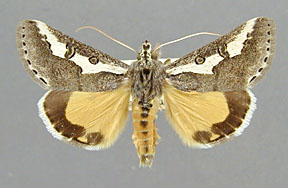Noctuidae - Agaristinae
by Robert W. Poole


|
Noctuidae - Agaristinae by Robert W. Poole |
 |
| Plates Genera
Male and female genitalia of Euscirrhopterus poeyi This segment of Nearctica is a non-technical version of unpublished research conducted by the author while employed at the Systematic Entomology Laboratory, USDA, at the National Museum of Natural History. Photographs are taken from material in the USNM. Distribution maps are based on specimens examined in several major North American collections. |
The species of the Agaristinae are found throughout the world. Although mostly tropical in distribution, a couple of species reach as far north as the boreal regions of North America. Agaristids have been commonly thought of as large, gaudy, day-flying moths rivaling the butterflies in their pulchritude. I confess I have never seen an agaristid species I thought unattractive. However many, if not the majority of agaristids are nocturnal, not diurnal. Indeed up until the middle of the twentieth century, the day fliers were often treated as a separate family Agaristidae and the night fliers relegated to the trifid noctuids. The difficulty with defining the agaristids as day fliers is that most of the characters used to define the group are only adaptations to flying during the daytime, e.g. clubbed antennae, reduced eyes, and multicolored wings and are not true of all of the genera of the subfamily. The only consistent character uniting all of the genera of Agaristinae is the absence of spermatophores. The spermatophore is an elongate, gelatinous stucture containing sperm and passed by the male and stored in the corpus bursae of the female genitalia. Spermatophores are found in all Noctuidae examined except for the Agaristinae. I have never seen a spermatophore in any dissection of an agaristinae species. I speculate that sperm are passed in a fluid to the female and not in a gelationous sheath. Perhaps as a consequence the vesica of the male aedeagous is most commonly very narrow and elongate, and the corpus bursae of the female genitalia is diaphanous and poorly developed. Other characters of the Agaristinae are: 1. At the rear margin of the metathorax anterior to the first abdominal segment there exists a pair of oval membranes call the counter tympanal membranes separated by a triangular septum. These structures can usually be seen when the abdomen has broken off cleanly from the thorax. Caudally from these counter tympanal membranes and projecting into the cavity formed by the first abdominal tergite are a pair of small bullae, each associated with one of the counter tympanal membranes. These bullae are called the counter tympanal cavities. Each opens into the space between the abdomen and the thorax. This opening is continuous with the tergo-pleural grove of the abdomen. One of the characteristic features of many of the Agaristinae, particularly the strictly day-flying species, is that these counter tyampanal cavities are greatly enlarged and fused together and not completely separated. This enlarged condition is best developed in the North American members of the Agaristinae by the genus Alypia. In many genera of the Agaristinae, however, the counter tympanal cavities are no more strongly developed than in other subfamilies of the trifid noctuids. 2. The valve of the male genitalia is elongate and covered with hairs. 3. A free pleurite between the tegumen and vinculum is present. 4. The clasper typically arises near the base of the valve and runs horizontally. 5. Typically the vesica of the aedeagus is narrow and poorly developed. 6. Typically the corpus bursae of the female genitalia is membranous and flimsy. Most species of the North American Agaristinae feed on species of the Onagraceae, Vitaceae, or Cactaceae. |
